
Determining the Metabolic Rate of the Thai Elderly
Sumavalee Chindapol*, John Blair, Paul Osmond and Deo PrasadPublished Date : 2017-01-01
DOI : 10.12982/cmujns.2017.0004
Journal Issues : Number 1 ,January - March 2017
ABSTRACT
The elderly have a slower metabolism than the young, which affects their thermal perceptions and comfort, particularly in hot-humid climates. Understanding these differences is important to identify the thermal comfort levels of the elderly. The available data from Thailand is insufficient, so we analyzed the literature for a proxy to estimate the metabolic equivalent of task (MET) rate for Thai elderly (60 years old and over). A Vietnamese database was the most reasonable proxy, since the body size of Thai and Vietnamese are similar, with considerable similarity in culture, food, and climate. This study applied 18 human metabolism equations derived from the literature to the Vietnamese data. Following statistical analysis of the measured MET rate of the Vietnamese elderly, seven studies were found to be accurate to within a ±10% margin of error: Schofield (1985), WHO (1985), Owen et al. (1986), EU (1993), Muller et al. (2004), Henry (2005), and Wells et al. (2009). Of these, the aggregate equation (Wells et al., 2009) was the most convincing method for estimating the MET rate of the Thai elderly, since it incorporates the Southeast Asian context and limits bias. In conclusion, using the most accurate equation, the MET rate of the average Thai elderly is calculated as 1,560 kcal/day for males and 1,230 kcal/day for females, equivalent to 43.10 W/m2 (0.966 kcal/kg/h) and 38.57 W/m2 (0.884 kcal/kg/h), respectively.
Keywords: Metabolic rate, Elderly, Hot humid climate, Thai, Vietnamese
INTRODUCTION
An individual’s metabolic equivalent of task (MET) is one of six main factors that determine thermal comfort. Most thermal comfort standards are based on the MET rate of an average adult. The elderly have a lower MET rate than younger adults, however, and typically have different thermal perceptions. Many studies have endorsed this position following clinical measurements conducted in the laboratory. First, the elderly have lower oxygen consumption in indirect calorimetry measurements (Kwan et al., 2004). Second, they have lower resting energy expenditure (REE) levels than the young as a result of progressive loss of fat free mass and a reduced MET rate in certain organs (Siervo et al., 2014). Third, their overall MET rate is also lower than that of younger adults (Pier et al., 1998; Lührmann et al., 2010). Although current calculation methods frequently result in significant over- or under-estimates of the MET rate, this paper describes how to calculate the MET rate in the Thai elderly with considerably more accuracy.
Six main factors are used to determine thermal comfort level: air temperature, humidity, air speed, radiant temperature, metabolic rate, and clothing insulation. MET rate is defined in the American Society of Heating, Refrigerating and Air-Conditioning Engineering, Inc., ASHRAE Standard 55-2004, as the heat transformation rate within an organism. The rate is expressed in ‘METs’ from the total energy produced per unit of surface area. ASHRAE (2004) suggested that the MET rate for a resting person is 58.15 W/m2 based upon an average 30-year-old man, 70 kg in weight, 1.75 m tall, and 1.8 m2 in surface area. It has also been applied for an average 30-year-old woman, 60 kg in weight, 1.70 m tall, and 1.6 m2 in surface area. ASHRAE Handbook (2009) determined that 1 MET seated at rest in an average man is equal to 50 kcal/h/m2. Based on the empirical research on MET rate (Harris and Benedict, 1918), the average MET rate has been calculated as 25.7 kcal/day in men and 24.5 kcal/day in women, which is equivalent to 1 kcal/kg/h. Although ASHRAE 55-2004 acknowledges that the elderly have a decreased MET rate compared with the young, no recommendation exists for how much lower the elderly rate might be.
ISO8996 (2004) defines four levels of accuracy as suitable for measuring MET rate: screening, observation, analysis, and expert. Screening is a coarse estimation of MET rate by employment occupation category. Observation estimates MET rate of subjects carrying out typical activities or tasks. Analysis measures heart rate as an input to calculating the MET rate, providing a more accurate estimate. The expert method is the most accurate, and relies on the direct measurement of oxygen consumption. However, it is complicated and requires tests in a laboratory. Indirect calorimetry is an alternative to the direct method, and has been applied more frequently, since the equipment is easier to use and the subjects need less preparation.
Oxygen consumption
Oxygen consumption in the elderly, at rest, has been found to be lower than that reported by the ISO8996 (2004) for the average adult of 3.5 ml/min/kg (Kwan et al., 2004; Sergi et al., 2010; Coelho-Ravagnani et al., 2013). These tests used the indirect calorimetry measurement of oxygen consumption. However, research comparing age groups in tropical and subtropical conditions is limited. While Chinese female and male younger adults consumed 3.3 and 3.0 ml/min/kg, respectively, older Chinese (over 65) consumed 2.8 ml/min/kg (Kwan et al., 2004). Sergi et al. (2010) confirmed a value of 2.9 ml/min/kg in resting Chinese elderly. The 50-year-old Brazilian’s O2 intake while resting was 2.7 ml/min/kg (Coelho-Ravagnani et al., 2013). Young Thai adults (age 25 years) consumed 3.9 ml/min/kg (Thongpresert and Chaivatsagool, 1985), whereas Thai elderly were much lower at 2.3 ml/min/kg when resting after doing yoga (Buranruk et al., 2010). Interestingly, research around the world with different ethnic groups has shown much lower oxygen consumption levels than the accepted standard, even with younger subjects.
Energy expenditure and MET rate
Metabolism can also be measured using energy expenditure. Basal energy expenditure (BEE) and resting energy expenditure (REE), also known as resting metabolic rate (RMR), both measure energy burned at rest. REE is usually mentioned as resting metabolic rate (RMR). Likewise, BEE and BMR are noted. BMR requires specific conditions and is usually measured in a laboratory or clinical environment, considered as Grade II of the controlling environment. The subject has to fast for 12 hours and have slept for 8 hours, with 4 hours of non-stimulating activity before testing to ensure that the digestive system is inactive. However, measuring RMR requires just 12 hours of non-vigorous activity and 30 min of resting at a neutral temperature (22°C) before testing (Grade III control) (Compher et al., 2006). BMR and RMR account for about 52-70% of total daily energy expenditure (Liu et al., 1995). RMR better represents typical daily life than BMR and requires fewer restrictions before measuring, although BMR more accurately represents basal energy expenditure.
The elderly have lower REE levels than the young as a result of progressive loss of fat-free mass and a reduced MET rate in certain organs (Siervo et al., 2014). BMR is also lower in the elderly (Fleisch, 1951 in FAO/WHO/UNU, 1981). Research data found a progressive decrease in BMR of approximately 15% in elderly (50-80 years old) Caucasians. The BMR of elderly Australians was measured at 5,726 kj/day, which is 458 kj/day, or 7.4%, lower than that of younger adults (Piers et al., 1998). The RMR of elderly Chinese females and males (60+ years),
measured using indirect calorimetry, was 6.5% and 7.8% lower (5,432 and 6,971 kj/day), respectively, than those of Chinese younger adults (Krems et al., 2005). However, the loss of fat-free mass is not the only factor contributing to reduced energy expenditure in the elderly. REE can be reduced by the progressive loss of muscle mass in particular body areas; for example, leg muscles in the elderly may have advanced loss of mass compared with other parts of the body (Hunter et al., 2001).
MET rate varies depending on demographic, anthropometric, and body composition characteristics: age, sex, ethnicity, weight, height, water body mass, fat mass, and fat-free mass. Although some researchers have suggested that the MET rates between ethnic groups, such as Egyptian, Burmese, Thai, Filipino, Japanese, Korean, and Indian are not significantly different (FAO/WHO/UNU, 1981), others have asserted the differences are distinct. For example, Asian adults living in the United States were measured with an 8.5% lower REE than the equation predicted for Westerners (Case et al., 1997). Moreover, the FAO/WHO/UNU equation overestimated BMR by 8-11.5% in tropical people (Henry and Rees, 1991), and the Schofield equation used in a FAO/WHO/UNU worldwide project overestimated BMR by 5-12% in Asian subjects (Henry, 2005) and 11% in Vietnamese subjects (Nhung et al., 2007).
METHODS
This paper applies 18 predictive equations available from the literature to estimate the MET rate for the Thai elderly and uses statistical analysis to select the most accurate method for the Thai context.
Identifying the database
The MET rate in Thai young adults has been measured directly (Thongpresert and Chaivatsagool, 1985), but not in the Thai elderly. This study first searched the literature for MET databases of the elderly in Asia, and compared body size characteristics of these databases (Vietnamese, Japanese, and Chinese elderly) with Thai elderly. The best-matched database was used as a proxy for the Thai elderly.
Note, however, that the body size comparison given below is not a direct anthropological measurement.
Methods for selecting the appropriate equation
This research examined 18 published MET rate equations that estimate REE for the elderly to select the most accurate equation. The 18 predictive equations are shown in Table 1.
Table 1. Comprehensive prediction equations of resting energy expenditure for older adults.
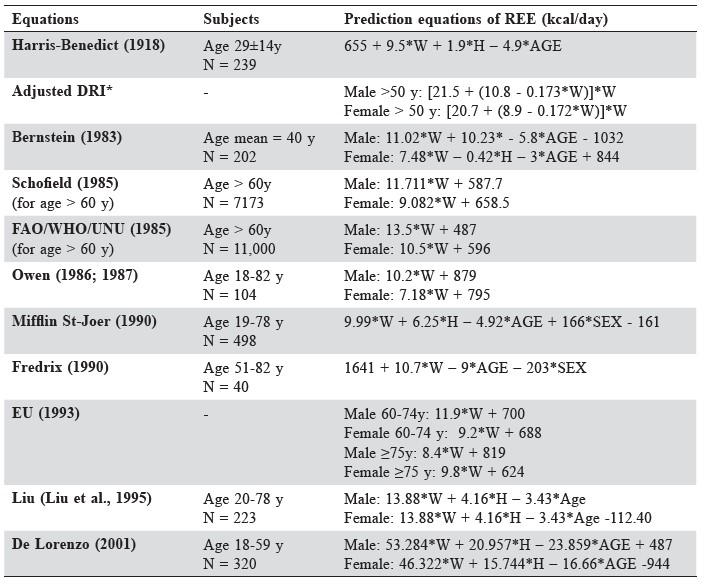
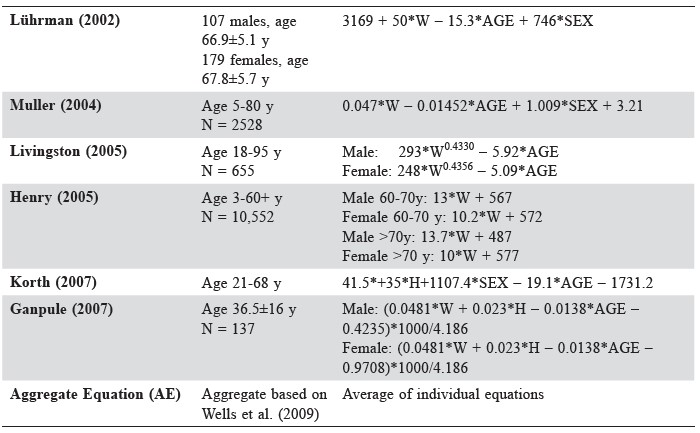
Note: Table has been modified and updated from Siervo et al. (2014); y = years; “-” means no data. *Adjusted Dietary Reference Intakes (DRI) (1975 in Miyake et al., 2011).
Siervo et al. (2014) suggested that the aggregate equation provides the most accurate REE estimation, with no significant bias in gender and age. Individual results were then tested statistically for their error and bias to arrive at a representative equation for the proxy of Thai elderly. The outcomes were compared to the measured data. The program ‘IBM SPSS Statistics’ 22 was used for statistical analysis and the most accurate method identified to estimate the MET rate for the Thai elderly. The two following methods identified the most accurate equation for the elderly.
Error tests. The percentage error was calculated from the different means between the measured REE and the predicted REE. The coefficient of variation (CV) can also illustrate the accuracy of data. The higher the error and CV values, the less accurate the results are. Equations with less than ±10% error were identified as more accurate.
Bias tests. The bias of the percentage error in weight and height was tested with Pearson’s Correlation. First, the significance of the difference between the predicted REE and the measured REE was measured. Next, bias analysis was conducted to assess the relationship of percentage of error to weight and height. Gender bias was not tested due to inadequate information. The following characteristics were recognized as having less bias:
• No significant difference between measured and predicted results.
• No apparent correlation between the percentage of error and weight or height.
RESULTS
The proxy database for the Thai elderly
The Vietnamese database has the least significant body size difference compared with the Thai. Table 2 shows a stronger correlation of overall characteristics of the Thai-Vietnamese elderly than the Thai-Japanese and Thai-Chinese. Although there is no significant correlation when considering gender, weight, and height of the Thai, Vietnamese, and Japanese elders, the Thai and Vietnamese databases shows a significant correlation in BMI (p<0.05). The selected Vietnamese database consisted of 35 males and 40 females (Nhung et al., 2007).
Table 2. Characteristics of the Thai, Vietnamese, and Japanese elderly.

Note: *Significant (p<0.05) compared to the Thai group.
The Vietnamese database was selected as the most appropriate for estimating the MET rate of the Thai elderly, since the Vietnamese body size is the most similar of the three ethnicities studied.
The Vietnamese database was then applied to all 18 equations and the accuracy of each determined.
The prediction of REE of Thai elderly
Using the 18 equations, the REE values of Thai elderly are much lower than the ISO8996 (2004) value (Table 3). MET rate can then be calculated from the predicted REE in both units – W/m2 (SI) and kcal/kg/h (IP), which reflect the individual’s skin surface area and weight.
These REE values vary by +/-32% the average value. The REE values calculated for Thai elderly averaged 1,552±512 kcal/day for males and 1,223±473 kcal/day for females. They are equivalent to 42.89 W/m2, or 0.96 kcal/kg/h, for males and 38.37 W/m2, or 0.88 kcal/kg/h, for females. The Vietnamese elderly record lower values of 40.82 W/m2, or 0.95 kcal/kg/h, for males and 37.38 W/m2, or 0.92 kcal/kg/h, for females (Nhung et al., 2007). These values of the Thai elderly are approximately 30% and 7% lower than 1 MET of the standard, calculated by skin surface area (W/m2) and by weight (kcal/kg/h), respectively.
However, these average values do not represent MET for the Thai elderly. The next method helps to identify the most appropriate method to determine the Thai elderly MET rate.
Table 3. Prediction of resting energy expenditure (REE) of Thai elderly.

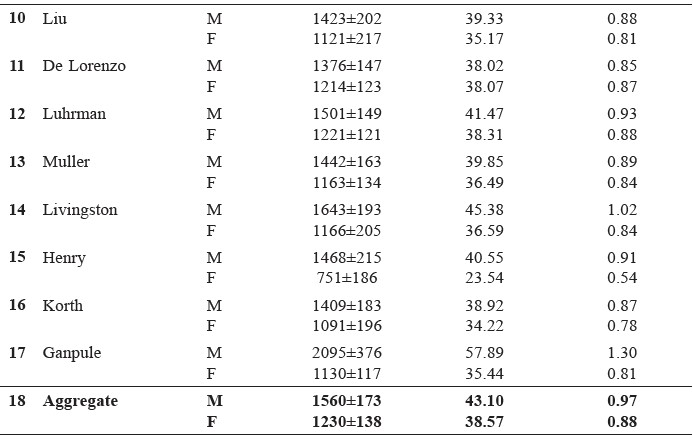
The most appropriate method to identify the MET rate for the Thai elderly
Two tests were used to eliminate the ineffective prediction equations for the Asian elderly. Based on these statistical tests, a qualitative approach helped determine the most appropriate method for the Thai elderly MET rate.
Error tests
The error of each REE calculation is shown in Figure 1. An error range within 10% and a CV within five units were considered acceptable (Figure 1). Based on this, the Harris-Benedict, Korth, and AE equations were identified as providing the most accurate predictions.
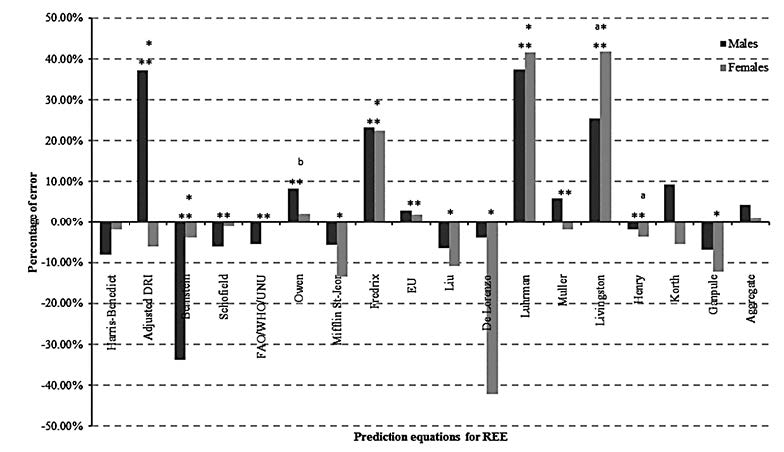
Figure 1. Calculation of mean percentage of errors from the predicted REE (kcal/day).
Note: *Mean percentage of error is more than ±10%. **Having a CV over five units. aSignificant difference between measured and calculated results (p<0.05). bSignificant bias between the percentage of error and weight and height (p<0.01).
Bias test
The bias between datasets was tested statistically to eliminate equations with limited applicability. The Lurhmann and Henry models showed a significant difference between measured and predicted REE. Pearson’s correlation examined the association between the percentage of the error on weight and height. The Owen model showed that the level of bias on both weight and height is highly significant (p<0.01). Therefore, the Lurhmann, Henry, and Owen models were eliminated based on the bias test.
DISCUSSION
According to both error and bias tests, three REE equations effectively predicted REE of the Asian elderly – the Harris-Benedict, Korth, and AE models. To identify the most appropriate model depends on whether the studies included Asian subjects and/or age specific parameters in their analysis to determine a predictive equation for calculating REE.
Eleven of the equations were based on Caucasian and/or non-Asian subjects; these were considered insufficiently effective for predicting the MET rate of Asians. Seven equations included Asian subjects in their original survey – Adjusted DRI, FAO/WHO/UNU, Owen, Liu, Henry, Ganpule, and the AE (see Table 4). In addition, as the MET rate reduces in the elderly along with the body mass, fat mass, and muscle mass (FAO/WHO/UNU, 1981), if the individual formula incorporates age and weight as a parameter, the results will be more accurate. Only the AE included Asians as well as decreasing weight and increasing age in their formulas (Table 4), making it the most accurate predictive equation for REE in the Vietnamese elderly.
Table 4. Consideration of age and ethnicity as a particular factor in experimental bias.

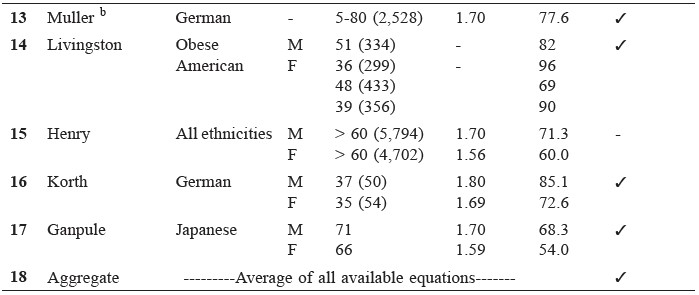
Note: aThe report covers many ethnicities around the world; Caucasian refers to Northern Europeans, including the British and North Americans; South American refers to Mexicans and Guatemalans; African refers to Gambians; and tropical refers to Papua New Guinean. bThis study did not cover gender differences. “-” means no data.
Given its appropriateness, we have adopted the AE method for the Thai database, even though it still overestimates by 1-4%, as shown in Figure 1. The MET rate of the average Thai elderly is calculated as 1,560 kcal/day for males and 1,230 kcal/day for females, equivalent to 43.10 W/m2 (0.966 kcal/kg/h) and 38.57 W/m2 (0.884 kcal/kg/h), respectively. It is approximately 7-30% lower than the RMR 58.15 W/m2 for average 30-year-old men in ISO8996 (2004). Regarding the Vietnamese data, the measured REE is 1,382 kcal/day for males and 1,142 kcal/day for females, equivalent to 40.82 W/m2 (0.95 kcal/kg/h) and 37.38 W/m2 (0.92 kcal/kg/h), respectively. The Thai and Vietnamese MET rates (W/m2) differ by approximately 4%. These results are similar to the percentage difference in weight and BMI between the two ethnicities. Therefore, the estimated REE can be assumed to be representative until a direct measurement of REE is undertaken with the Thai elderly. Further study should include metabolic measurement of the Thai elderly, which would permit an accurate predictive equation to be developed.
REFERENCES
ASHRAE. 2009. Handbook – Fundamentals in Chapter 9: Thermal Comfort. ASHRAE, Atlanta.
Bernstein, R. S., J. C. Thornton, M. U. Yang, J. Wang, A. M. Redmond, R. N. X. Pi-Sunyer, and T. B. Van Itallie. Pierson, 1983. Prediction of the resting metabolic rate in obese patients. The American Journal of Clinical Nutrition. 37(APRIL): 595-602.
Buranruk, O., S. La Grow, S. Ladawan, P. Makarawate, T. Suwanich, and N. Leelayuwat. 2010. Thai yoga as an appropriate alternative physical activity for older adults. Journal of Complementary and Integrative Medicine. 7(1). doi:10.2202/1553-3840.1290.
Byrne, N. M., A. P. Hills, G. R. Hunter, R. L. Weinsier, and Y. Schutz. 2005. Metabolic equivalent: one size does not fit all. Journal of applied physiology. 99(3): 1112-1119. doi:10.1152/japplphysiol.00023.2004.
Coelho-Ravagnani, C. d. F., F. C. L. Melo, F. C. P. Ravagnani, F. H. P. Burini, and R. C. Burini. 2013. Estimation of the metabolic equivalent (MET) of an exercise protocol based on indirect calorimetry. Revista Brasileira de Medicina do Esporte. 19(2): 134-138. doi:10.1590/S1517-86922013000200013.
Compher, C., D. Frankenfield, N. Keim, and L. Roth-Yousey. 2006. Best practice methods to apply to measurement of resting metabolic rate in adults: a systematic review. Journal of the American Dietetic Association. 106(6): 881-903. doi:10.1016/j.jada.2006.02.009.
De Lorenzo, A., A. Tagliabue, A. Andreoli, G. Testolin, M. Comelli, and P. Deurenberg. 2001. Measured and predicted resting metabolic rate in Italian males and females, aged 18-59 y. European Journal of Clinical Nutrition. 55: 208–214. Retrieved from www.nature.com/ejcn.
EU. 1993. Reports of the Scientific Committee for Food (Thirty-first series): Nutrient and energy intakes for the European Community. Luxembourg: Commission of the European Communities, Directorate-General Telecommunications, Information Industries and Innovation.
Fanger, O. P., and J. Toftum. 2002. Extension of the PMV model to non-air-conditioned buildings in warm climates. Energy and Buildings. 34(6): 533-536. doi:10.1016/S0378-7788(02)00003-8.
FAO/WHO/UNU. 1981. BASAL METABOLIC RATE IN MAN: Joint FAO/WHO/UNU Expert Consultation on Energy and Protein Requirements. Rome.
FAO/WHO/UNU. 1985. Energy and Protein Requirement: Report of a Joint FAO/WHO/UNU Expert Consultation. Geneva: World Health Organization.
Fredrix, E. W., P. B. Soeters, I. M. Deerenberg, A. D. Kester, M. F. von Meyenfeldt, and W. H. Saris. 1990. Resting and sleeping energy expenditure in the elderly. European Journal of Clinical Nutrition. 44(10): 741-747.
Ganpule, A. A., S. Tanaka, K. Ishikawa-Takata, and I. Tabata. 2007. Interindividual variability in sleeping metabolic rate in Japanese subjects. European Journal of Clinical Nutrition. 61(11): 1256–1261. doi:10.1038/sj.ejcn.1602645.
Harris, J. A., and F. G. Benedict. 1918. A Biometric study of human basal metabolism. Proceedings of the National Academy of Sciences of the United States of America. 4(12): 370-373.
Henry, C. J. K., and D. G. Rees. 1991. New predictive equations for the estimation of basal metabolic rate in tropical peoples. European Journal of Clinical Nutrition. 45(4): 177-185.
Henry, C. J. K. 2005. Basal metabolic rate studies in humans: measurement and development of new equations. Public Health Nutrition. 8(7a). doi:10.1079/PHN2005801.
Hunter, G. R., R. L. Weinsier, B. A. Gower, and C. Wetzstein. 2001. Age-related decrease in resting energy expenditure in sedentary white women: Effects of regional differences in lean and fat mass. American Journal of Clinical Nutrition. 73(2): 333-337.
ISO8996, 2004. Ergonomics of the thermal environment - Determination of metabolic rate (Second edition). Geneva, Switzerland: International Organization for Standardization.
Korth, O., A. Bosy-Westphal, P. Zschoche, C. C. Glüer, M. Heller, and M. J. Müller. 2007. Influence of methods used in body composition analysis on the prediction of resting energy expenditure. European Journal of Clinical Nutrition. 61(5): 582-589. doi:10.1038/ sj.ejcn.1602556.
Krems, C., P. M. Lührmann, A. Strassburg, B. Hartmann, and M. Neuhäuser-Berthold. 2005. Lower resting metabolic rate in the elderly may not be entirely due to changes in body composition. European Journal of Clinical Nutrition. 59(2): 255-262. doi:10.1038/sj.ejcn.1602066.
Kwan, M., J. Woo, and T. Kwok. 2004. The standard oxygen consumption value equivalent to one metabolic equivalent (3.5 ml/min/kg) is not appropriate for elderly people. International Journal of Food Sciences and Nutrition. 55(3): 179-182. doi:10.1080/09637480410001725201.
Liu, H. Y., Y. F. Lu, and W. J. Chen. 1995. Predictive Equations for Basal Metabolic Rate in Chinese Adults: A cross-validation study. Journal of the American Dietetic Association. 95(12): 1403–1408. doi:10.1016/ S0002-8223(95)00369-X.
Livingston, E. H., and I. Kohlstadt. 2005. Simplified resting metabolic rate-predicting formulas for normal-sized and obese individuals. Obesity Research. 13(7): 1255–1262. doi:10.1038/oby.2005.149
Lührmann, P. M., B. M. Herbert, C. Krems, and M. Neuhäuser-Berthold. 2002. A new equation especially developed for predicting resting metabolic rate in the elderly for easy use in practice. European Journal of Nutrition. 41(3): 108-113.
Mifflin, M. D., S. T. St Jeor, L. A. Hill, B. J. Scott, S. A. Daugherty, and Y. O. Koh. 1990. A new predictive equation for resting energy expenditure in healthy individuals: Original Research Communicaations - methods. The American Journal of Clinical Nutrition. 51: 241-247.
Miyake, R., S. Tanaka, K. Ohkawara, K. Ishiwara-Tanaka, Y. Hikihara, E. Taguri, J. Kayashita, and I. Tabata. 2011. Validity of Predictive Equations for Basal Metabolic Rate in Japanese Adults. Journal of Nutritional Science and Vitaminology. 57(3): 224-232. doi:10.3177/jnsv.57.224.
Muller, M. J., A. Bosy-Westphal, S. Klaus, G. Kreymann, P. M. Lührmann, M. Neuhäuser-Berthold, R. Noack, K. M. Pirke, P. Platte, O. Selberg, and J. Steiniger. 2004. World Health Organization equations have shortcomings for predicting resting energy expenditure in persons from a modern, affluent population: generation of a new reference standard from a retrospective analysis of a German database of resting energy expenditure. The American Journal of Clinical Nutrition. 80: 1379-1390.
Nhung, B. T., N. C. Khan, L. T. Hop, N. T. Lam, N. L. B. Khanh, D. T. K. Lien, M. Nakamori, V. T. Hien, A. Aassu, and S. Yamamoto. 2007. Resting metabolic rate of elderly Vietnamese. Annals of Nutrition and Metabolism. 51(1): 7-13.
Okura, T., M. Koda, F. Ando, N. Niino, and H. Shimokata. 2003. Relationship of Resting Energy Expenditure with Body Fat Distribution and Abnominal Fatness in Japanese Population. Journal of Physiological Anthropology and Applied Human Science. 22(1): 47-52.
Owen, O. E., E. Kavle, R. S. Owen, M. Polansky, S. Caprio, M. A. Mozzoli, Z. V. Kendrick, M. C. Bushman, and G. Boden. 1986. A reappraisal of caloric requirements in healthy women. The American Journal of Clinical Nutrition. 44(July): 1-19.
Owen, O. E., J. L. Holup, D. A. D’Alessio, E. S. Craig, M. Polansky, K. J. Smalley, E. C. Kavle, M. C. Bushman, L. R. Owen, M. A. Mozzoli, Z. V. Kendrick, and G. H. Boden. 1987. A reappraisal of the caloric requirements of men. The American Journal of Clinical Nutrition. 46: 875-885.
Piers, L. S., M. J. Soares, L. M. McCormack, and K. O’Dea. 1998. Is there evidence for an age-related reduction in metabolic rate? Journal of Applied Physiology. 85(6): 2196-2204.
Wells, J. C. K., S. Charoensiriwath, and P. Treleaven. 2011. Reproduction, aging, and body shape by three-dimensional photonic scanning in Thai men and women. American Journal of Human Biology: the official journal of the Human Biology Council. 23(3): 291-298. doi:10.1002/ajhb.21151.
Wells, J. C. K., J. E. Williams, D. Haroun, M. S. Fewtrell, A. Colantuoni, and M. Siervo. 2009. Aggregate predictions improve accuracy when calculating metabolic variables used to guide treatment. The American Journal of Clinical Nutrition. 89(2): 491-499. doi:10.3945/ajcn.2008. 26629.
Schofield, W. N. 1985. Predicting Basal Metabolic Rate, New standard and review of previous work. Human Nutrition. 39: 5-41.
Sergi, G., A. Coin, S. Sarti, E. Perissinotto, M. Peloso, S. Mulone, M. Trolese, E. M. Inelmen, G. Enzi, and E. Manzato. 2010. Resting VO2, maximal VO2 and metabolic equivalents in free-living healthy elderly women. Clinical Nutrition (Edinburgh, Scotland). 29(1): 84-88. doi:10.1016/j.clnu.2009.07.010.
Siervo, M., S. Bertoli, A. Battezzati, J. C. K. Wells, J. Lara, C. Ferraris, and A. Tagliabue. 2014. Accuracy of predictive equations for the measurement of resting energy expenditure in older subjects. Clinical Nutrition (Edinburgh, Scotland). 33(4): 613-619. doi:10.1016/j.clnu.2013. 09.009.
Thongprasert, K., and W. Chaivatsagool. 1985. BMR, RMR, and energy expenditure in various activities. Internal Medicine. 1(2): 88-91.
Sumavalee Chindapol1,2*, John Blair2, Paul Osmond2 and Deo Prasad2
1 Faculty of Architecture, Chiang Mai University, Chiang Mai 50200, Thailand
2 Faculty of Built Environment, University of New South Wales, Sydney 2052,
Australia
*Corresponding author. E-mail: sumavalee@gmail.com
Total Article Views

